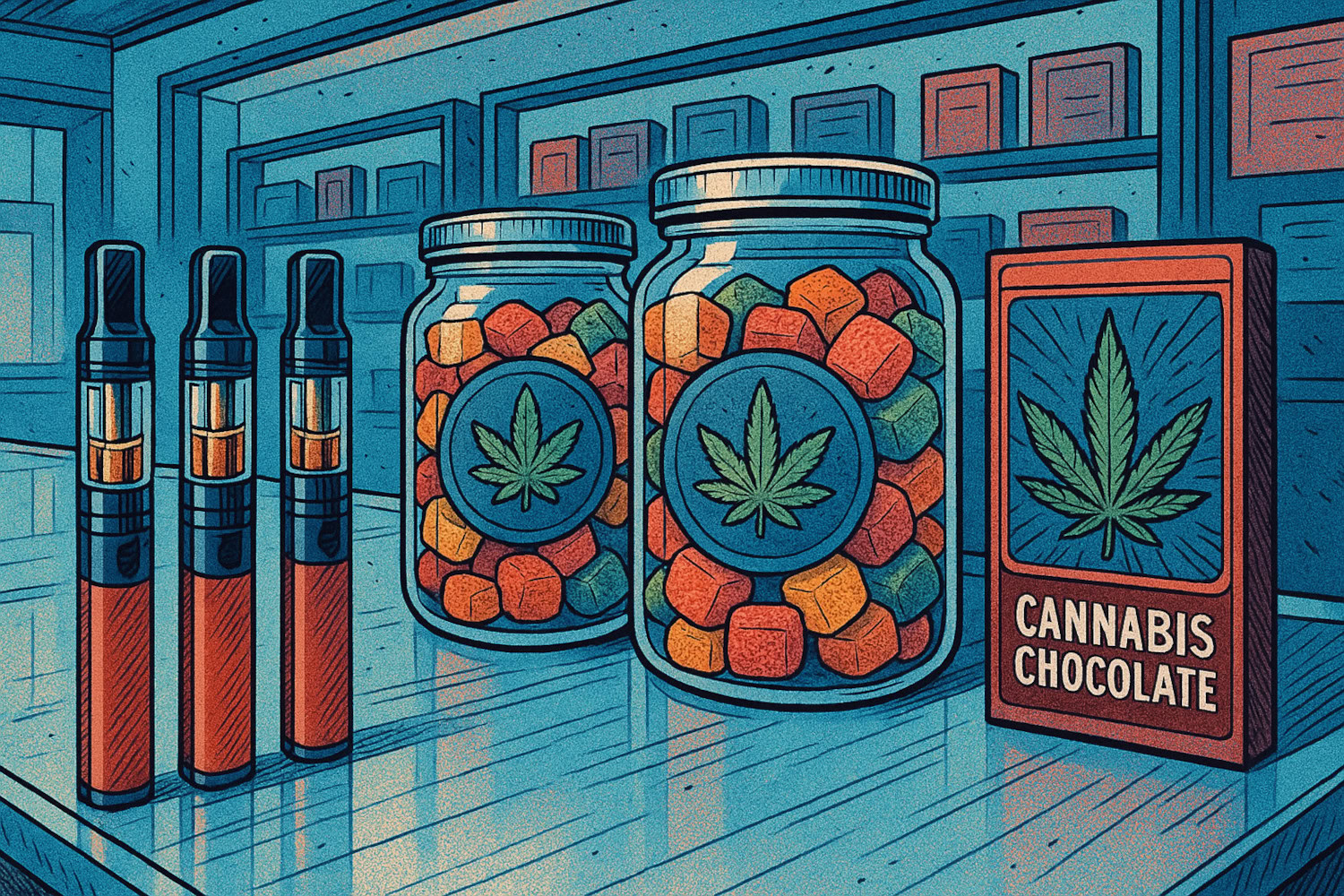In recent years, vape pens have become a crowd favorite for both recreational and medical users. Their convenience, discretion, and efficiency have made them a go-to option for many. However, vape pens aren't immortal.
Similar to other electronics, these nifty devices have a finite lifespan, and understanding the factors that influence their longevity can make a significant difference in quality. There are many things that go into the lifespan of the weed pen.
Parts of a Weed Pen
Before understanding the intricacies of a vape pen's lifespan, it’s important to know the various components that make up these handy devices.
- Battery: The battery provides the necessary electricity to heat the coil and vaporize the cannabis extract. Batteries come in different capacities, impacting the number of puffs your pen can deliver before needing a recharge or replacement.
- Atomizer/Heating Element: This component houses the heating coil that is responsible for turning cannabis oil into an inhalable vapor. When activated, the coil rapidly heats up, allowing the oil to vaporize.
- Cartridge: The cartridge holds the cannabis extract, be it distillate, live resin, or CO2. The cartridge is attached to the atomizer and provides the content that will be vaporized.
- Mouthpiece: This is the part you put your lips to and where the vapor emerges.
- Button/Draw Activation Sensor: Some vape pens have a button to manually activate the heating element, while others are draw-activated, meaning they activate when you inhale through the mouthpiece. The activation method can impact the wear and tear on the vape pen.
How Long Do Carts Last?
Vape cartridge longevity primarily depends on things like build quality, usage patterns, and care. High-quality cartridges tend to last longer, whereas cheaper options may have a shorter lifespan.
Cannabis vape cartridges typically come in various sizes, with 0.5 grams and 1 gram being the most common. The size you choose can significantly influence how long the contents last.
The viscosity or thickness of the vape liquid or oil also plays a role in how long the cartridges last. Sufficiently low viscosity is necessary for the vaporizer to function efficiently, as these devices rely on wicking to deliver the liquid to the atomizer from the cartridge reservoir.1 Higher terpene content can reduce the viscosity and potentially lead to quicker consumption, especially when vaping at higher temperatures.
Distillate cartridges often have a longer lifespan compared to live rosin or live resin cartridges. This is because distillate usually contains fewer terpenes and maintains a consistent viscosity. Live rosin and live resin cartridges, on the other hand, offer a fuller cannabinoid profile but may be consumed faster due to their higher terpene content.
Ultimately, the duration of a vape cartridge's contents largely depends on the user's frequency of use, the size of the cartridge, and the specific concentrate or extract being vaporized.
How Long Does a Battery Last?

The battery is the powerhouse that keeps the whole operation running in a vape.
The typical charge duration of a vape pen battery can vary widely depending on the battery's capacity, usage patterns, and the power required to heat the atomizer. On average, a single charge can last anywhere from a few hours to several days, but this can vary. Smaller, lower-capacity batteries may require more frequent charging, while larger, high-capacity batteries offer longer usage per charge.
Frequent use, higher temperature settings, and power-hungry atomizers can drain the battery faster. At the same time, light or intermittent use can prolong the time between charges.
The wear and tear on the battery over time, as well as factors like temperature exposure, moisture, and physical damage, can also affect the device's overall longevity. Proper maintenance, careful handling, and following the manufacturer's guidelines can extend the functional life of your vape pen.
How Long Do Dab Pens Last?
Dab pens, often called wax pens, offer a distinct vaping experience tailored to concentrates like wax, shatter, or crumble. These devices come in various forms, from traditional dab pens to all-in-one devices designed for ultimate convenience.
Dab pens, designed specifically for concentrates, differ from standard vape pens. They are built to handle wax's thicker, more potent wax consistency and other extracts. As a result, their components and lifespan considerations may also differ.
Traditional dab pens usually consist of a battery and a replaceable atomizer or coil. Depending on usage and maintenance, the atomizer parts can last anywhere from three months to a year. High-quality dab pens may last longer due to their durable construction. Some reputable companies, such as PAX and Puffco, offer lifetime warranties on their dab pens, showcasing confidence in the longevity of their products.
The Connection Between Quality and Longevity in Weed Pens

At this point, plenty of weed pens are out there. As such, the quality of these devices varies significantly, ranging from high-end, reliable devices to budget-friendly options that may compromise on durability and performance.
Distillate cartridges, while often chosen for their high THC content, are considered by some as the lowest quality due to the extraction process. Distillation strips plant compounds like fats, chlorophyll, terpenes, and other minor cannabinoids, leaving just THC, which can result in a one-dimensional experience.2 Additionally, some distillates may contain additives like MCT oil or flavorings, which can affect the overall quality and safety.
While convenient and portable, disposable vape pens may lack a decent battery life, often making them single-use or short-term solutions.
High-quality weed pens are generally designed with safer, more durable components that withstand the test of time, like glass and ceramic, rather than plastic and metal. These pens often include premium batteries, atomizers, and materials, reducing the likelihood of frequent replacements.
Quality batteries are a cornerstone of longevity. Devices with reliable, long-lasting batteries can provide extended usage between charges and endure longer overall.
Higher-quality devices are also more durable and offer a safer and more consistent vaping experience. They may feature advanced temperature controls, efficient heating elements, and safeguards against issues like leaks and overheating.
It's not just the quality of the device that matters – the quality of the concentrate being used also plays a significant role. High-quality concentrates like live resin and rosin, made from fresh, premium cannabis material, can result in a better vaping experience and potentially prolong the lifespan of your device.
How to Extend the Lifespan of Your Weed Pen
To maximize the lifespan of your weed pen and get the most out of your investment, you can implement several tips and practices.
1. Proper Usage
Be conscious of your usage patterns. Avoid taking excessively long draws, which can overheat the coil and battery. Moderation can go a long way in extending your pen's life.
2. Cleaning and Maintenance
Periodically clean the components of your vape pen, including the mouthpiece, tank, and battery connection. Residue buildup can affect performance and flavor.
If your device has a replaceable atomizer or coil, make sure to change it as needed – typically, every few months or when you notice a decline in vapor quality.
3. Quality Concentrates
Opt for high-quality cannabis concentrates, such as live resin or rosin, to minimize the risk of clogs, residue, and other issues that can affect your device's functionality.
4. Temperature Control
Adjust your vape pen's temperature settings to match the concentrate being used. This can prevent overheating, which can strain the battery and other components.
5. Proper Storage
When not in use, store your vape pen upright to prevent any leakage of the concentrate into the battery compartment. Keep your vape pen in a cool, dry place to avoid extreme temperatures and moisture exposure, which can adversely affect the battery and other components.
6. Battery Care
Avoid overcharging your battery. Unplug it as soon as it's fully charged to prevent unnecessary strain on the battery. Always use the charger provided by the manufacturer or a compatible charger. Using the wrong charger can damage the battery.
7. Maintenance Checks
Periodically check your vape pen for signs of wear and tear, such as loose connections, damaged wiring, or leaking. Promptly address any issues to prevent further damage.
8. Avoid Cheap or Counterfeit Products
Invest in reputable, quality vape pens and cartridges made with glass and ceramic. Cheap or counterfeit products may save money upfront, but they often have a shorter lifespan and can pose safety risks.
When It's Time to Replace Your Weed Pen

As with any electronic device, vape pens have a finite lifespan, and there is a time when replacement is the most prudent choice. Here are some warning signs and common failure modes that indicate it's time to replace your weed pen:
1. Decreased Vapor Quality
It might be time for a replacement if you notice a significant drop in flavor and vapor production. This could be due to a worn-out atomizer or coil.
2. Frequent Clogs and Leaks
Even after thorough cleaning and maintenance, frequent clogs and leaks can signal that the device's components are deteriorating. These problems often indicate it's time for a new vape pen.
3. Battery Performance
If your battery no longer holds a charge like it used to and you find yourself needing to recharge frequently, it might be time to invest in a new vape pen. Over time, the battery's capacity can degrade, resulting in reduced performance.
4. Physical Damage
Physical damage to the vape pen, such as cracks or broken components, can lead to safety hazards and hinder the device's operation. In such cases, you'll want to replace your device.
5. Inconsistent Functionality
If your vape pen becomes increasingly unreliable and experiences inconsistent heating, activation issues, or other functional problems, it's a strong indicator that it has reached the end of its useful life.
6. Outdated Technology
New vape pens are developed with enhanced features and safety measures as technology evolves. If you're using an older model, upgrading to a more recent device can provide a superior experience and potentially improved longevity.
7. Safety Concerns
Any indication that your vape pen is malfunctioning in a way that may pose safety risks, such as overheating or excessive heat, should prompt an immediate replacement to avoid potential harm.
8. End of Warranty
If its warranty no longer covers your vape pen and you’re experiencing problems, investing in a new, reliable device might be more cost-effective than repairing an old one.
References
- Meehan-Atrash J, Rahman I. Cannabis Vaping: Existing and Emerging Modalities, Chemistry, and Pulmonary Toxicology. Chem Res Toxicol. 2021;34(10):2169-2179. doi:10.1021/acs.chemrestox.1c00290 ↩︎
- López-Olmos C, García-Valverde MT, Hidalgo J, Ferrerio-Vera C, Sánchez de Medina V. Comprehensive comparison of industrial cannabinoid extraction techniques: Evaluation of the most relevant patents and studies at pilot scale. Frontiers in Natural Products. 2022;1. doi:https://doi.org/10.3389/fntpr.2022.1043147 ↩︎
The information in this article and any included images or charts are for educational purposes only. This information is neither a substitute for, nor does it replace, professional legal advice or medical advice, diagnosis, or treatment. If you have any concerns or questions about laws, regulations, or your health, you should always consult with an attorney, physician or other licensed professional.




